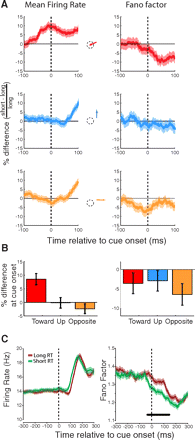Changes in the response rate and response variability of area V4 neurons during the preparation of saccadic eye movements
- PMID: 20018834
- PMCID: PMC3774656
- DOI: 10.1152/jn.00689.2009
Changes in the response rate and response variability of area V4 neurons during the preparation of saccadic eye movements
Abstract
The visually driven responses of macaque area V4 neurons are modulated during the preparation of saccadic eye movements, but the relationship between presaccadic modulation in area V4 and saccade preparation is poorly understood. Recent neurophysiological studies suggest that the variability across trials of spiking responses provides a more reliable signature of motor preparation than mean firing rate across trials. We compared the dynamics of the response rate and the variability in the rate across trials for area V4 neurons during the preparation of visually guided saccades. As in previous reports, we found that the mean firing rate of V4 neurons was enhanced when saccades were prepared to stimuli within a neuron's receptive field (RF) in comparison with saccades to a non-RF location. Further, we found robust decreases in response variability prior to saccades and found that these decreases predicted saccadic reaction times for saccades both to RF and non-RF stimuli. Importantly, response variability predicted reaction time whether or not there were any accompanying changes in mean firing rate. In addition to predicting saccade direction, the mean firing rate could also predict reaction time, but only for saccades directed to the RF stimuli. These results demonstrate that response variability of area V4 neurons, like mean response rate, provides a signature of saccade preparation. However, the two signatures reflect complementary aspects of that preparation.
Figures




Similar articles
-
Motor intention activity in the macaque's lateral intraparietal area. I. Dissociation of motor plan from sensory memory.J Neurophysiol. 1996 Sep;76(3):1439-56. doi: 10.1152/jn.1996.76.3.1439. J Neurophysiol. 1996. PMID: 8890265
-
Dynamic sensitivity of area V4 neurons during saccade preparation.Proc Natl Acad Sci U S A. 2009 Aug 4;106(31):13046-51. doi: 10.1073/pnas.0902412106. Epub 2009 Jul 21. Proc Natl Acad Sci U S A. 2009. PMID: 19622736 Free PMC article.
-
Global selection of saccadic target features by neurons in area v4.J Neurosci. 2014 May 7;34(19):6700-6. doi: 10.1523/JNEUROSCI.0867-13.2014. J Neurosci. 2014. PMID: 24806696 Free PMC article.
-
Presaccadic discrimination of receptive field stimuli by area V4 neurons.Vision Res. 2009 Jun;49(10):1227-32. doi: 10.1016/j.visres.2008.03.018. Epub 2008 May 23. Vision Res. 2009. PMID: 18501949 Free PMC article.
-
A physiological perspective on fixational eye movements.Vision Res. 2016 Jan;118:31-47. doi: 10.1016/j.visres.2014.12.006. Epub 2014 Dec 20. Vision Res. 2016. PMID: 25536465 Free PMC article. Review.
Cited by
-
Decision Signals in the Local Field Potentials of Early and Mid-Level Macaque Visual Cortex.Cereb Cortex. 2021 Jan 1;31(1):169-183. doi: 10.1093/cercor/bhaa218. Cereb Cortex. 2021. PMID: 32852540 Free PMC article.
-
Neural activity in the mouse claustrum in a cross-modal sensory selection task.Neuron. 2022 Feb 2;110(3):486-501.e7. doi: 10.1016/j.neuron.2021.11.013. Epub 2021 Dec 3. Neuron. 2022. PMID: 34863367 Free PMC article.
-
A cortical substrate for memory-guided orienting in the rat.Neuron. 2011 Oct 20;72(2):330-43. doi: 10.1016/j.neuron.2011.07.010. Neuron. 2011. PMID: 22017991 Free PMC article.
-
Predicting Perceptual Decisions Using Visual Cortical Population Responses and Choice History.J Neurosci. 2019 Aug 21;39(34):6714-6727. doi: 10.1523/JNEUROSCI.0035-19.2019. Epub 2019 Jun 24. J Neurosci. 2019. PMID: 31235648 Free PMC article.
-
Neural correlates of perisaccadic visual mislocalization in extrastriate cortex.Nat Commun. 2024 Jul 27;15(1):6335. doi: 10.1038/s41467-024-50545-0. Nat Commun. 2024. PMID: 39068199 Free PMC article.
References
-
- Armstrong KM, Fitzgerald JK, Moore T. Changes in visual receptive fields with microstimulation of frontal cortex. Neuron 50: 791–798, 2006 - PubMed
-
- Benjamini Y, Hochberg Y. Controlling the false discovery rate: a practical and powerful approach to multiple testing. Roy Stat Soci Series [B] 57: 289–289, 1995
-
- Chelazzi L, Miller EK, Duncan J, Desimone R. A neural basis for visual search in inferior temporal cortex. Nature 363: 345–347, 1993 - PubMed
MeSH terms
Grants and funding
LinkOut - more resources
Full Text Sources
Research Materials

